Individual Case Study: Post-Project Review of the Burj Khalifa Project
VerifiedAdded on 2022/08/23
|9
|2483
|25
Report
AI Summary
This report provides a post-project review of the Burj Khalifa, focusing on the application and effectiveness of project management principles. It analyzes the project's successes and failures, including delays, budget overruns, and labor issues. The report delves into the project management framework, methodologies employed (such as waterfall and SCRUM), and critical analysis using project management terminologies. The report examines the factors contributing to the project's success, such as design innovation, and its failures, including cost and time overruns. Furthermore, the report suggests improvements for future project performance, emphasizing the importance of risk assessment, stakeholder management, and clear communication. The report concludes with recommendations for enhancing project delivery processes and adapting theoretical project management approaches for improved outcomes.
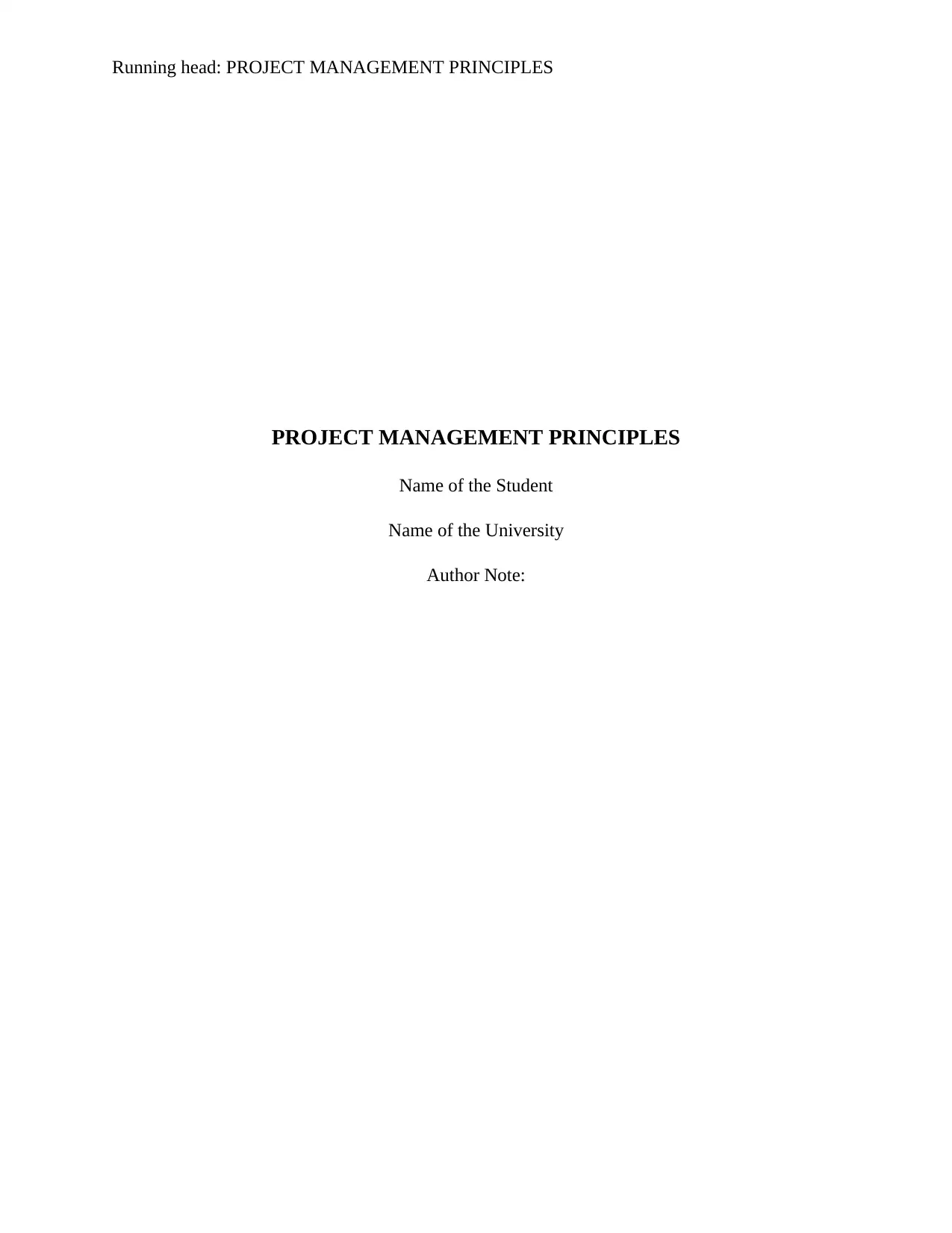
Running head: PROJECT MANAGEMENT PRINCIPLES
PROJECT MANAGEMENT PRINCIPLES
Name of the Student
Name of the University
Author Note:
PROJECT MANAGEMENT PRINCIPLES
Name of the Student
Name of the University
Author Note:
Paraphrase This Document
Need a fresh take? Get an instant paraphrase of this document with our AI Paraphraser
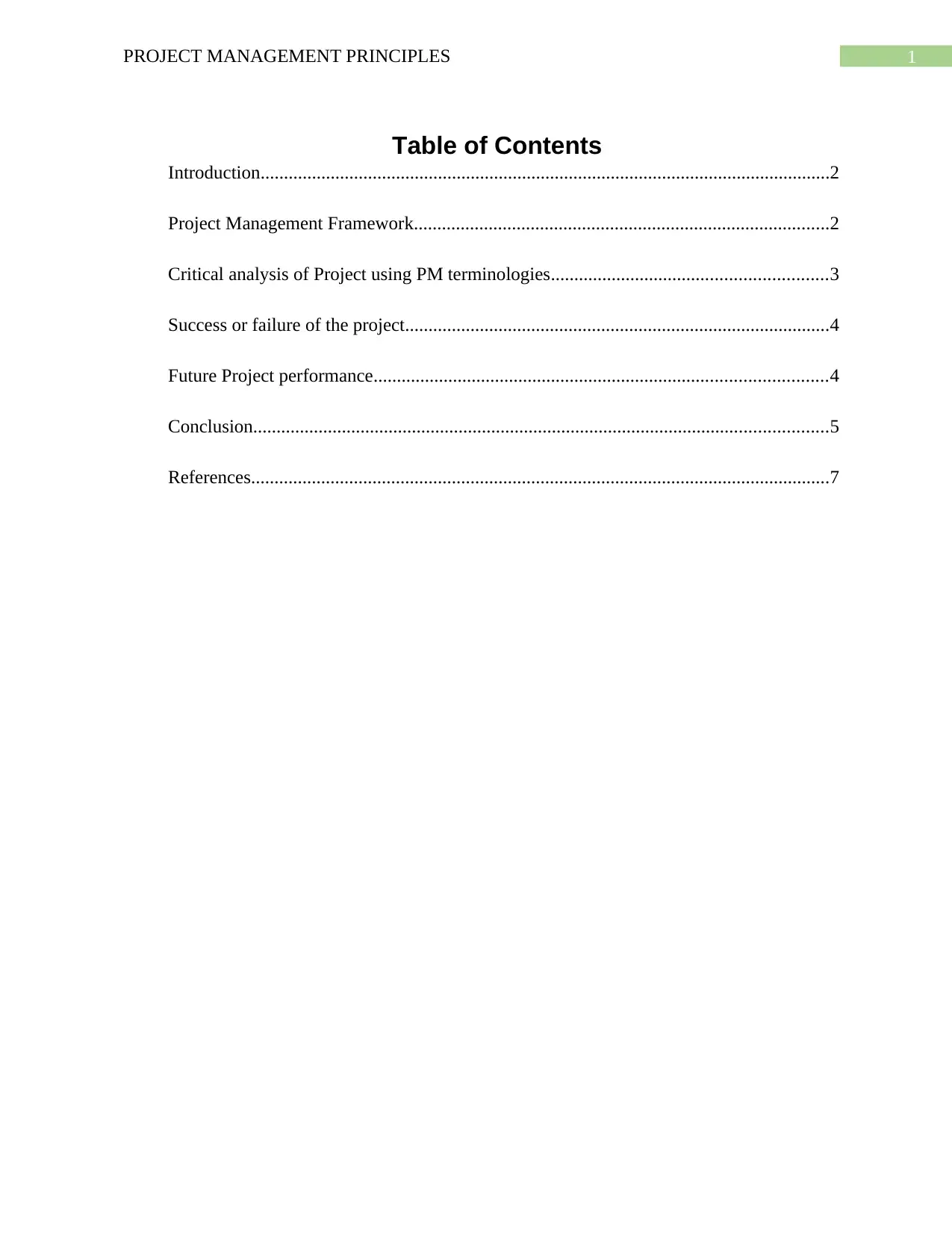
1PROJECT MANAGEMENT PRINCIPLES
Table of Contents
Introduction..........................................................................................................................2
Project Management Framework.........................................................................................2
Critical analysis of Project using PM terminologies...........................................................3
Success or failure of the project...........................................................................................4
Future Project performance.................................................................................................4
Conclusion...........................................................................................................................5
References............................................................................................................................7
Table of Contents
Introduction..........................................................................................................................2
Project Management Framework.........................................................................................2
Critical analysis of Project using PM terminologies...........................................................3
Success or failure of the project...........................................................................................4
Future Project performance.................................................................................................4
Conclusion...........................................................................................................................5
References............................................................................................................................7
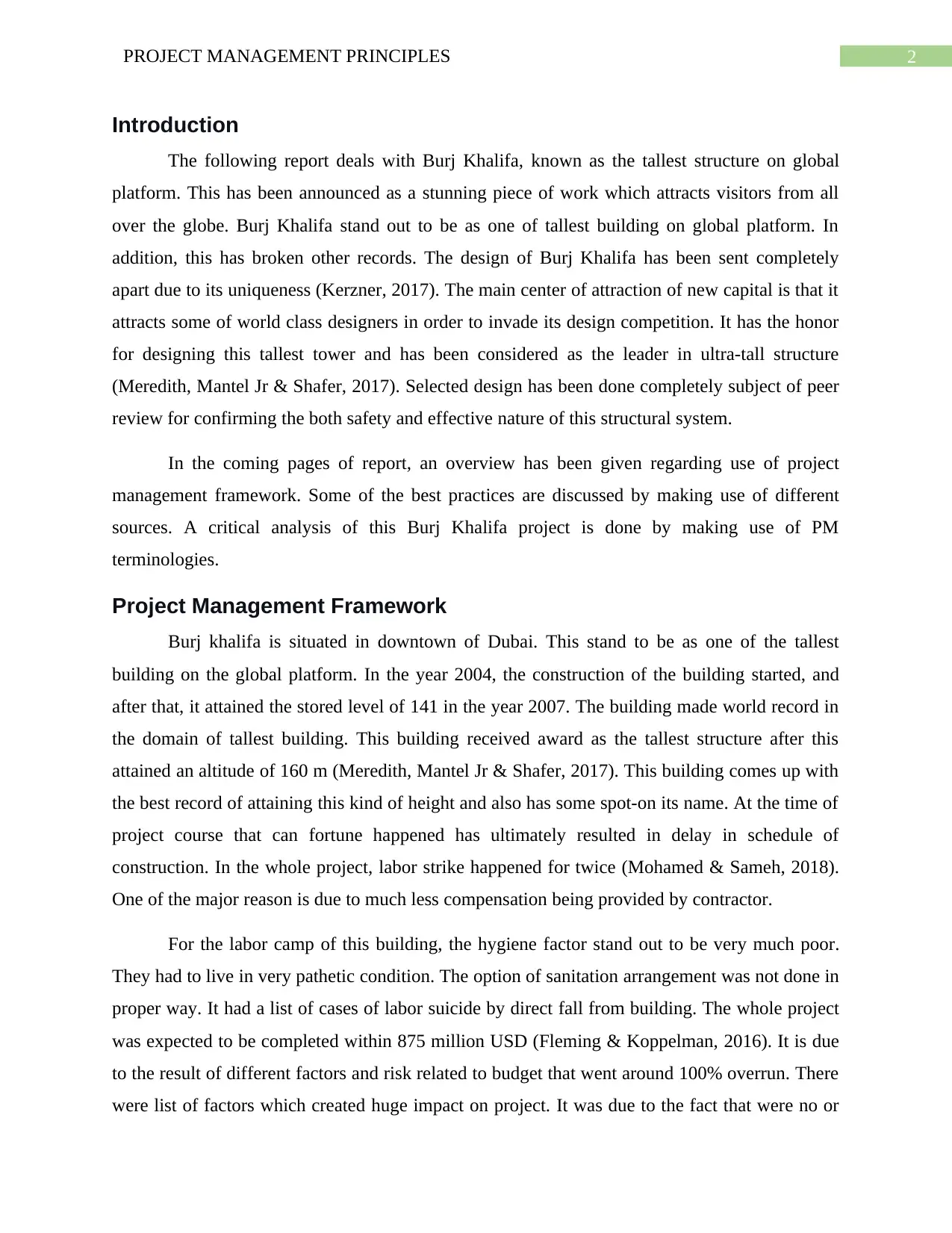
2PROJECT MANAGEMENT PRINCIPLES
Introduction
The following report deals with Burj Khalifa, known as the tallest structure on global
platform. This has been announced as a stunning piece of work which attracts visitors from all
over the globe. Burj Khalifa stand out to be as one of tallest building on global platform. In
addition, this has broken other records. The design of Burj Khalifa has been sent completely
apart due to its uniqueness (Kerzner, 2017). The main center of attraction of new capital is that it
attracts some of world class designers in order to invade its design competition. It has the honor
for designing this tallest tower and has been considered as the leader in ultra-tall structure
(Meredith, Mantel Jr & Shafer, 2017). Selected design has been done completely subject of peer
review for confirming the both safety and effective nature of this structural system.
In the coming pages of report, an overview has been given regarding use of project
management framework. Some of the best practices are discussed by making use of different
sources. A critical analysis of this Burj Khalifa project is done by making use of PM
terminologies.
Project Management Framework
Burj khalifa is situated in downtown of Dubai. This stand to be as one of the tallest
building on the global platform. In the year 2004, the construction of the building started, and
after that, it attained the stored level of 141 in the year 2007. The building made world record in
the domain of tallest building. This building received award as the tallest structure after this
attained an altitude of 160 m (Meredith, Mantel Jr & Shafer, 2017). This building comes up with
the best record of attaining this kind of height and also has some spot-on its name. At the time of
project course that can fortune happened has ultimately resulted in delay in schedule of
construction. In the whole project, labor strike happened for twice (Mohamed & Sameh, 2018).
One of the major reason is due to much less compensation being provided by contractor.
For the labor camp of this building, the hygiene factor stand out to be very much poor.
They had to live in very pathetic condition. The option of sanitation arrangement was not done in
proper way. It had a list of cases of labor suicide by direct fall from building. The whole project
was expected to be completed within 875 million USD (Fleming & Koppelman, 2016). It is due
to the result of different factors and risk related to budget that went around 100% overrun. There
were list of factors which created huge impact on project. It was due to the fact that were no or
Introduction
The following report deals with Burj Khalifa, known as the tallest structure on global
platform. This has been announced as a stunning piece of work which attracts visitors from all
over the globe. Burj Khalifa stand out to be as one of tallest building on global platform. In
addition, this has broken other records. The design of Burj Khalifa has been sent completely
apart due to its uniqueness (Kerzner, 2017). The main center of attraction of new capital is that it
attracts some of world class designers in order to invade its design competition. It has the honor
for designing this tallest tower and has been considered as the leader in ultra-tall structure
(Meredith, Mantel Jr & Shafer, 2017). Selected design has been done completely subject of peer
review for confirming the both safety and effective nature of this structural system.
In the coming pages of report, an overview has been given regarding use of project
management framework. Some of the best practices are discussed by making use of different
sources. A critical analysis of this Burj Khalifa project is done by making use of PM
terminologies.
Project Management Framework
Burj khalifa is situated in downtown of Dubai. This stand to be as one of the tallest
building on the global platform. In the year 2004, the construction of the building started, and
after that, it attained the stored level of 141 in the year 2007. The building made world record in
the domain of tallest building. This building received award as the tallest structure after this
attained an altitude of 160 m (Meredith, Mantel Jr & Shafer, 2017). This building comes up with
the best record of attaining this kind of height and also has some spot-on its name. At the time of
project course that can fortune happened has ultimately resulted in delay in schedule of
construction. In the whole project, labor strike happened for twice (Mohamed & Sameh, 2018).
One of the major reason is due to much less compensation being provided by contractor.
For the labor camp of this building, the hygiene factor stand out to be very much poor.
They had to live in very pathetic condition. The option of sanitation arrangement was not done in
proper way. It had a list of cases of labor suicide by direct fall from building. The whole project
was expected to be completed within 875 million USD (Fleming & Koppelman, 2016). It is due
to the result of different factors and risk related to budget that went around 100% overrun. There
were list of factors which created huge impact on project. It was due to the fact that were no or
⊘ This is a preview!⊘
Do you want full access?
Subscribe today to unlock all pages.

Trusted by 1+ million students worldwide
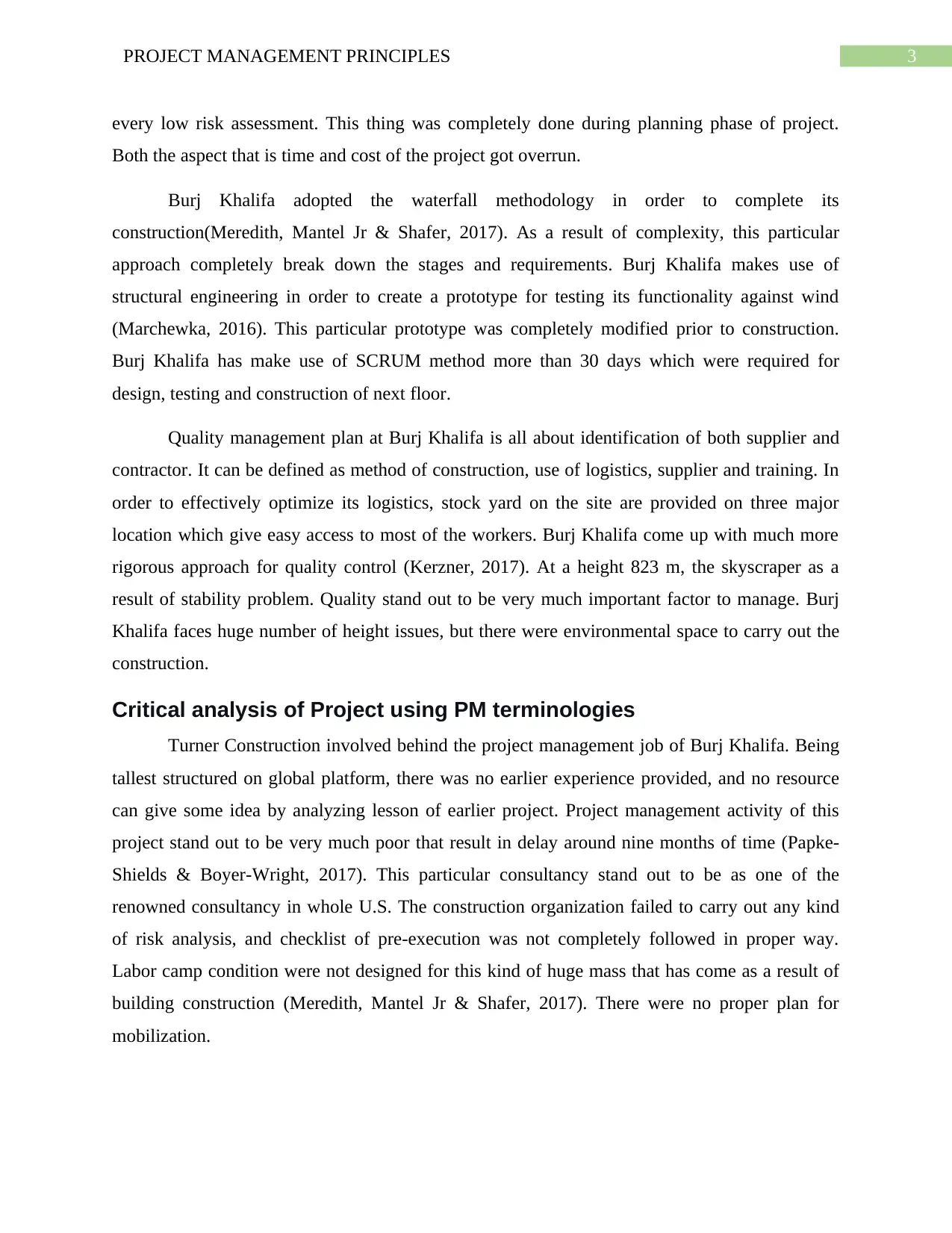
3PROJECT MANAGEMENT PRINCIPLES
every low risk assessment. This thing was completely done during planning phase of project.
Both the aspect that is time and cost of the project got overrun.
Burj Khalifa adopted the waterfall methodology in order to complete its
construction(Meredith, Mantel Jr & Shafer, 2017). As a result of complexity, this particular
approach completely break down the stages and requirements. Burj Khalifa makes use of
structural engineering in order to create a prototype for testing its functionality against wind
(Marchewka, 2016). This particular prototype was completely modified prior to construction.
Burj Khalifa has make use of SCRUM method more than 30 days which were required for
design, testing and construction of next floor.
Quality management plan at Burj Khalifa is all about identification of both supplier and
contractor. It can be defined as method of construction, use of logistics, supplier and training. In
order to effectively optimize its logistics, stock yard on the site are provided on three major
location which give easy access to most of the workers. Burj Khalifa come up with much more
rigorous approach for quality control (Kerzner, 2017). At a height 823 m, the skyscraper as a
result of stability problem. Quality stand out to be very much important factor to manage. Burj
Khalifa faces huge number of height issues, but there were environmental space to carry out the
construction.
Critical analysis of Project using PM terminologies
Turner Construction involved behind the project management job of Burj Khalifa. Being
tallest structured on global platform, there was no earlier experience provided, and no resource
can give some idea by analyzing lesson of earlier project. Project management activity of this
project stand out to be very much poor that result in delay around nine months of time (Papke-
Shields & Boyer-Wright, 2017). This particular consultancy stand out to be as one of the
renowned consultancy in whole U.S. The construction organization failed to carry out any kind
of risk analysis, and checklist of pre-execution was not completely followed in proper way.
Labor camp condition were not designed for this kind of huge mass that has come as a result of
building construction (Meredith, Mantel Jr & Shafer, 2017). There were no proper plan for
mobilization.
every low risk assessment. This thing was completely done during planning phase of project.
Both the aspect that is time and cost of the project got overrun.
Burj Khalifa adopted the waterfall methodology in order to complete its
construction(Meredith, Mantel Jr & Shafer, 2017). As a result of complexity, this particular
approach completely break down the stages and requirements. Burj Khalifa makes use of
structural engineering in order to create a prototype for testing its functionality against wind
(Marchewka, 2016). This particular prototype was completely modified prior to construction.
Burj Khalifa has make use of SCRUM method more than 30 days which were required for
design, testing and construction of next floor.
Quality management plan at Burj Khalifa is all about identification of both supplier and
contractor. It can be defined as method of construction, use of logistics, supplier and training. In
order to effectively optimize its logistics, stock yard on the site are provided on three major
location which give easy access to most of the workers. Burj Khalifa come up with much more
rigorous approach for quality control (Kerzner, 2017). At a height 823 m, the skyscraper as a
result of stability problem. Quality stand out to be very much important factor to manage. Burj
Khalifa faces huge number of height issues, but there were environmental space to carry out the
construction.
Critical analysis of Project using PM terminologies
Turner Construction involved behind the project management job of Burj Khalifa. Being
tallest structured on global platform, there was no earlier experience provided, and no resource
can give some idea by analyzing lesson of earlier project. Project management activity of this
project stand out to be very much poor that result in delay around nine months of time (Papke-
Shields & Boyer-Wright, 2017). This particular consultancy stand out to be as one of the
renowned consultancy in whole U.S. The construction organization failed to carry out any kind
of risk analysis, and checklist of pre-execution was not completely followed in proper way.
Labor camp condition were not designed for this kind of huge mass that has come as a result of
building construction (Meredith, Mantel Jr & Shafer, 2017). There were no proper plan for
mobilization.
Paraphrase This Document
Need a fresh take? Get an instant paraphrase of this document with our AI Paraphraser
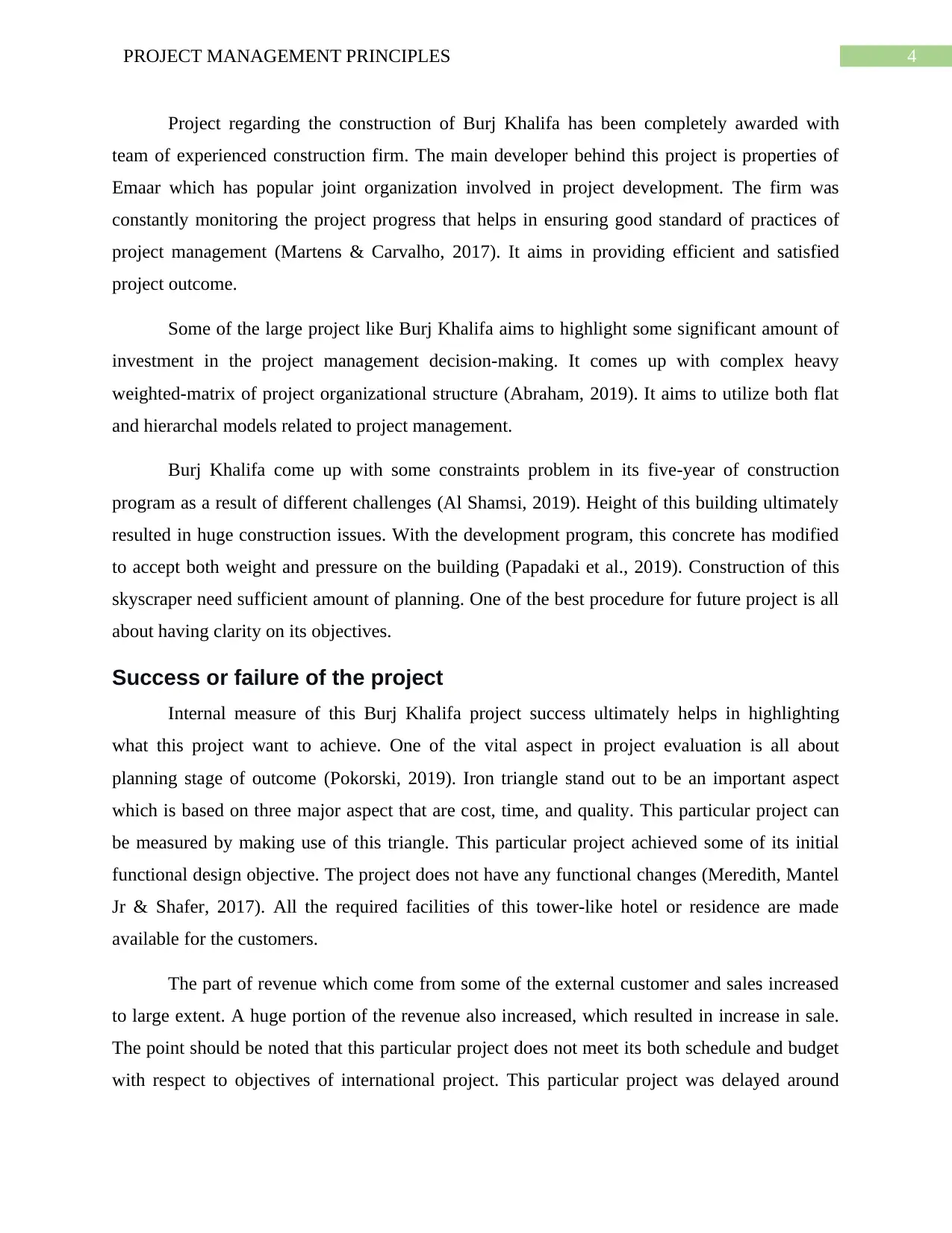
4PROJECT MANAGEMENT PRINCIPLES
Project regarding the construction of Burj Khalifa has been completely awarded with
team of experienced construction firm. The main developer behind this project is properties of
Emaar which has popular joint organization involved in project development. The firm was
constantly monitoring the project progress that helps in ensuring good standard of practices of
project management (Martens & Carvalho, 2017). It aims in providing efficient and satisfied
project outcome.
Some of the large project like Burj Khalifa aims to highlight some significant amount of
investment in the project management decision-making. It comes up with complex heavy
weighted-matrix of project organizational structure (Abraham, 2019). It aims to utilize both flat
and hierarchal models related to project management.
Burj Khalifa come up with some constraints problem in its five-year of construction
program as a result of different challenges (Al Shamsi, 2019). Height of this building ultimately
resulted in huge construction issues. With the development program, this concrete has modified
to accept both weight and pressure on the building (Papadaki et al., 2019). Construction of this
skyscraper need sufficient amount of planning. One of the best procedure for future project is all
about having clarity on its objectives.
Success or failure of the project
Internal measure of this Burj Khalifa project success ultimately helps in highlighting
what this project want to achieve. One of the vital aspect in project evaluation is all about
planning stage of outcome (Pokorski, 2019). Iron triangle stand out to be an important aspect
which is based on three major aspect that are cost, time, and quality. This particular project can
be measured by making use of this triangle. This particular project achieved some of its initial
functional design objective. The project does not have any functional changes (Meredith, Mantel
Jr & Shafer, 2017). All the required facilities of this tower-like hotel or residence are made
available for the customers.
The part of revenue which come from some of the external customer and sales increased
to large extent. A huge portion of the revenue also increased, which resulted in increase in sale.
The point should be noted that this particular project does not meet its both schedule and budget
with respect to objectives of international project. This particular project was delayed around
Project regarding the construction of Burj Khalifa has been completely awarded with
team of experienced construction firm. The main developer behind this project is properties of
Emaar which has popular joint organization involved in project development. The firm was
constantly monitoring the project progress that helps in ensuring good standard of practices of
project management (Martens & Carvalho, 2017). It aims in providing efficient and satisfied
project outcome.
Some of the large project like Burj Khalifa aims to highlight some significant amount of
investment in the project management decision-making. It comes up with complex heavy
weighted-matrix of project organizational structure (Abraham, 2019). It aims to utilize both flat
and hierarchal models related to project management.
Burj Khalifa come up with some constraints problem in its five-year of construction
program as a result of different challenges (Al Shamsi, 2019). Height of this building ultimately
resulted in huge construction issues. With the development program, this concrete has modified
to accept both weight and pressure on the building (Papadaki et al., 2019). Construction of this
skyscraper need sufficient amount of planning. One of the best procedure for future project is all
about having clarity on its objectives.
Success or failure of the project
Internal measure of this Burj Khalifa project success ultimately helps in highlighting
what this project want to achieve. One of the vital aspect in project evaluation is all about
planning stage of outcome (Pokorski, 2019). Iron triangle stand out to be an important aspect
which is based on three major aspect that are cost, time, and quality. This particular project can
be measured by making use of this triangle. This particular project achieved some of its initial
functional design objective. The project does not have any functional changes (Meredith, Mantel
Jr & Shafer, 2017). All the required facilities of this tower-like hotel or residence are made
available for the customers.
The part of revenue which come from some of the external customer and sales increased
to large extent. A huge portion of the revenue also increased, which resulted in increase in sale.
The point should be noted that this particular project does not meet its both schedule and budget
with respect to objectives of international project. This particular project was delayed around
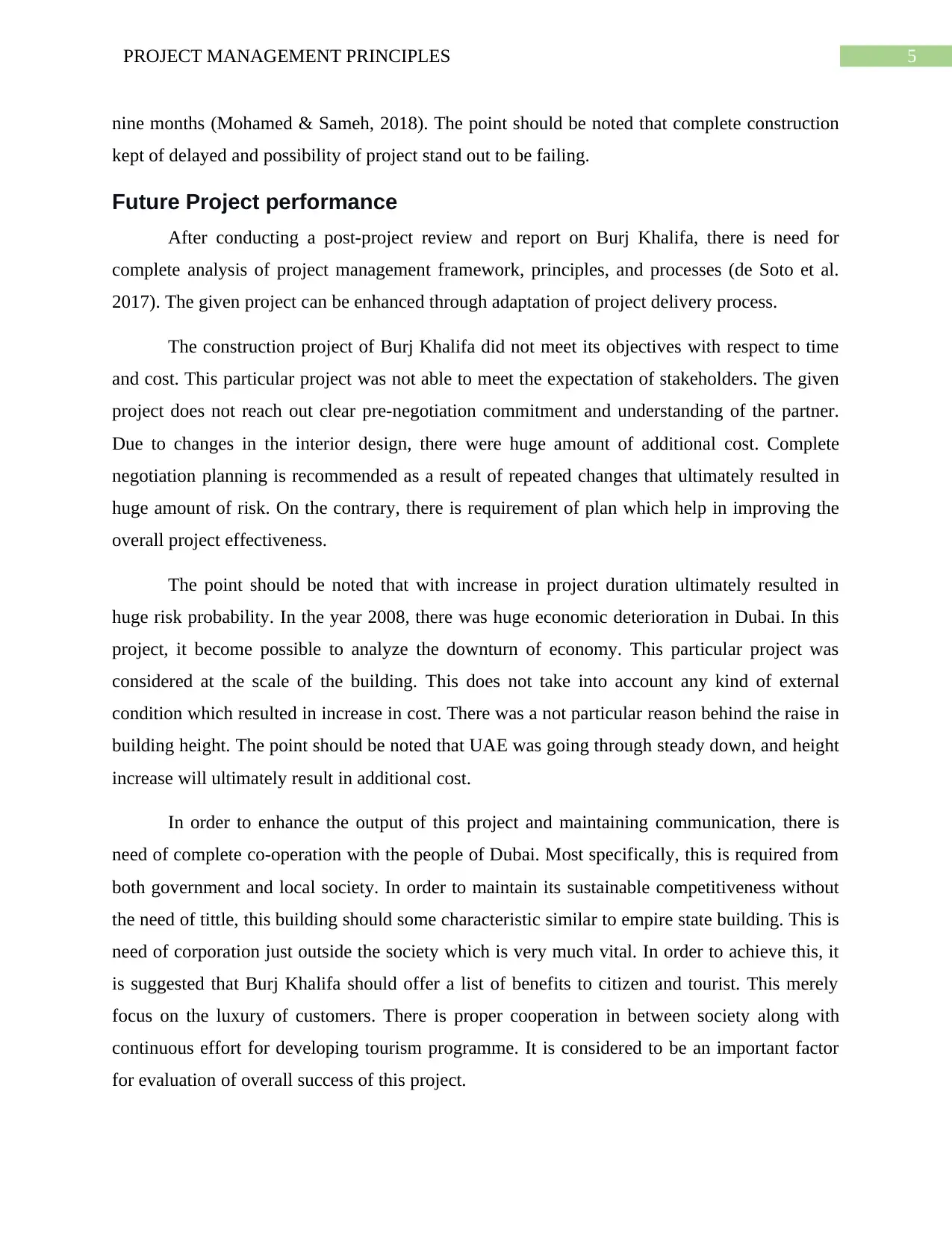
5PROJECT MANAGEMENT PRINCIPLES
nine months (Mohamed & Sameh, 2018). The point should be noted that complete construction
kept of delayed and possibility of project stand out to be failing.
Future Project performance
After conducting a post-project review and report on Burj Khalifa, there is need for
complete analysis of project management framework, principles, and processes (de Soto et al.
2017). The given project can be enhanced through adaptation of project delivery process.
The construction project of Burj Khalifa did not meet its objectives with respect to time
and cost. This particular project was not able to meet the expectation of stakeholders. The given
project does not reach out clear pre-negotiation commitment and understanding of the partner.
Due to changes in the interior design, there were huge amount of additional cost. Complete
negotiation planning is recommended as a result of repeated changes that ultimately resulted in
huge amount of risk. On the contrary, there is requirement of plan which help in improving the
overall project effectiveness.
The point should be noted that with increase in project duration ultimately resulted in
huge risk probability. In the year 2008, there was huge economic deterioration in Dubai. In this
project, it become possible to analyze the downturn of economy. This particular project was
considered at the scale of the building. This does not take into account any kind of external
condition which resulted in increase in cost. There was a not particular reason behind the raise in
building height. The point should be noted that UAE was going through steady down, and height
increase will ultimately result in additional cost.
In order to enhance the output of this project and maintaining communication, there is
need of complete co-operation with the people of Dubai. Most specifically, this is required from
both government and local society. In order to maintain its sustainable competitiveness without
the need of tittle, this building should some characteristic similar to empire state building. This is
need of corporation just outside the society which is very much vital. In order to achieve this, it
is suggested that Burj Khalifa should offer a list of benefits to citizen and tourist. This merely
focus on the luxury of customers. There is proper cooperation in between society along with
continuous effort for developing tourism programme. It is considered to be an important factor
for evaluation of overall success of this project.
nine months (Mohamed & Sameh, 2018). The point should be noted that complete construction
kept of delayed and possibility of project stand out to be failing.
Future Project performance
After conducting a post-project review and report on Burj Khalifa, there is need for
complete analysis of project management framework, principles, and processes (de Soto et al.
2017). The given project can be enhanced through adaptation of project delivery process.
The construction project of Burj Khalifa did not meet its objectives with respect to time
and cost. This particular project was not able to meet the expectation of stakeholders. The given
project does not reach out clear pre-negotiation commitment and understanding of the partner.
Due to changes in the interior design, there were huge amount of additional cost. Complete
negotiation planning is recommended as a result of repeated changes that ultimately resulted in
huge amount of risk. On the contrary, there is requirement of plan which help in improving the
overall project effectiveness.
The point should be noted that with increase in project duration ultimately resulted in
huge risk probability. In the year 2008, there was huge economic deterioration in Dubai. In this
project, it become possible to analyze the downturn of economy. This particular project was
considered at the scale of the building. This does not take into account any kind of external
condition which resulted in increase in cost. There was a not particular reason behind the raise in
building height. The point should be noted that UAE was going through steady down, and height
increase will ultimately result in additional cost.
In order to enhance the output of this project and maintaining communication, there is
need of complete co-operation with the people of Dubai. Most specifically, this is required from
both government and local society. In order to maintain its sustainable competitiveness without
the need of tittle, this building should some characteristic similar to empire state building. This is
need of corporation just outside the society which is very much vital. In order to achieve this, it
is suggested that Burj Khalifa should offer a list of benefits to citizen and tourist. This merely
focus on the luxury of customers. There is proper cooperation in between society along with
continuous effort for developing tourism programme. It is considered to be an important factor
for evaluation of overall success of this project.
⊘ This is a preview!⊘
Do you want full access?
Subscribe today to unlock all pages.

Trusted by 1+ million students worldwide
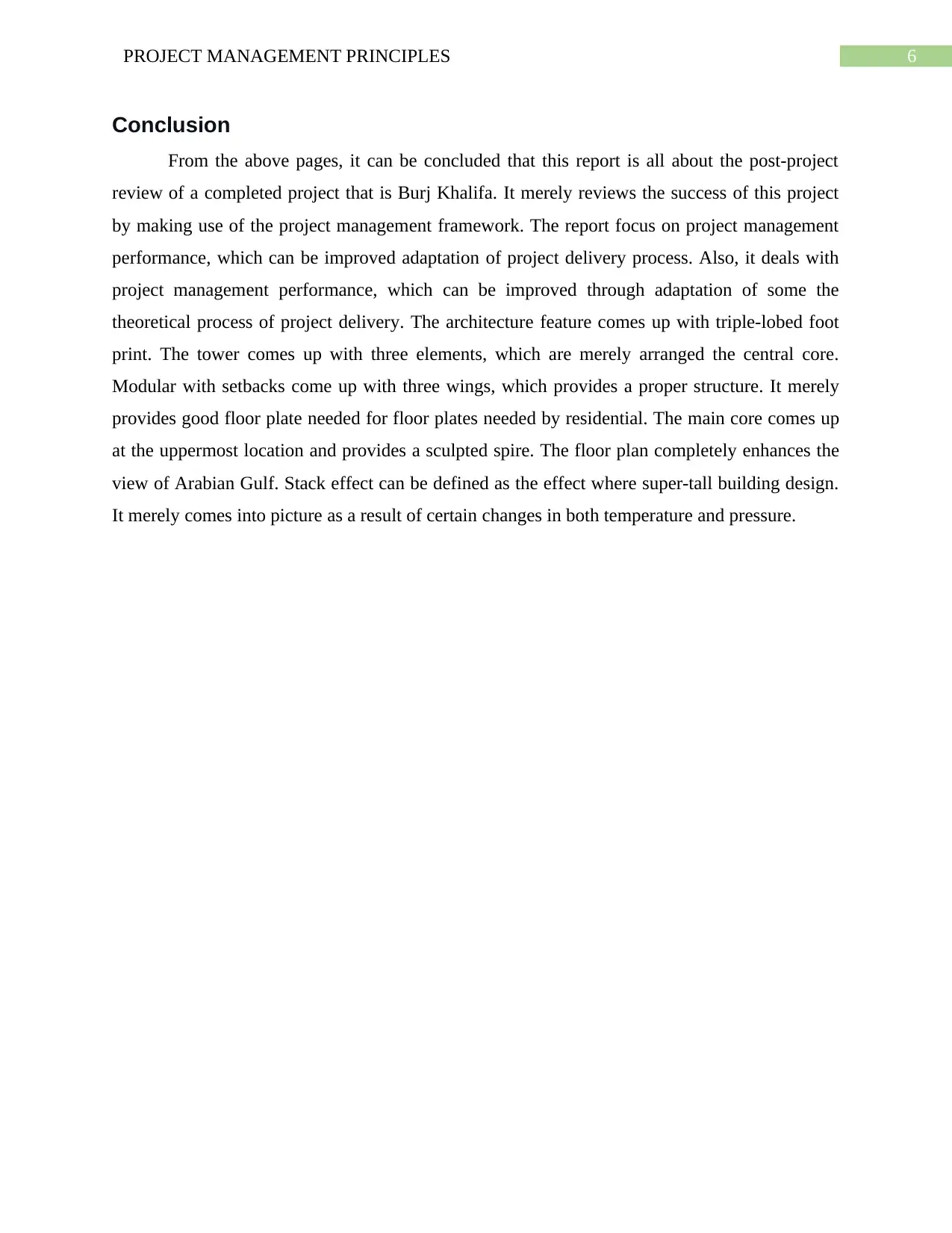
6PROJECT MANAGEMENT PRINCIPLES
Conclusion
From the above pages, it can be concluded that this report is all about the post-project
review of a completed project that is Burj Khalifa. It merely reviews the success of this project
by making use of the project management framework. The report focus on project management
performance, which can be improved adaptation of project delivery process. Also, it deals with
project management performance, which can be improved through adaptation of some the
theoretical process of project delivery. The architecture feature comes up with triple-lobed foot
print. The tower comes up with three elements, which are merely arranged the central core.
Modular with setbacks come up with three wings, which provides a proper structure. It merely
provides good floor plate needed for floor plates needed by residential. The main core comes up
at the uppermost location and provides a sculpted spire. The floor plan completely enhances the
view of Arabian Gulf. Stack effect can be defined as the effect where super-tall building design.
It merely comes into picture as a result of certain changes in both temperature and pressure.
Conclusion
From the above pages, it can be concluded that this report is all about the post-project
review of a completed project that is Burj Khalifa. It merely reviews the success of this project
by making use of the project management framework. The report focus on project management
performance, which can be improved adaptation of project delivery process. Also, it deals with
project management performance, which can be improved through adaptation of some the
theoretical process of project delivery. The architecture feature comes up with triple-lobed foot
print. The tower comes up with three elements, which are merely arranged the central core.
Modular with setbacks come up with three wings, which provides a proper structure. It merely
provides good floor plate needed for floor plates needed by residential. The main core comes up
at the uppermost location and provides a sculpted spire. The floor plan completely enhances the
view of Arabian Gulf. Stack effect can be defined as the effect where super-tall building design.
It merely comes into picture as a result of certain changes in both temperature and pressure.
Paraphrase This Document
Need a fresh take? Get an instant paraphrase of this document with our AI Paraphraser
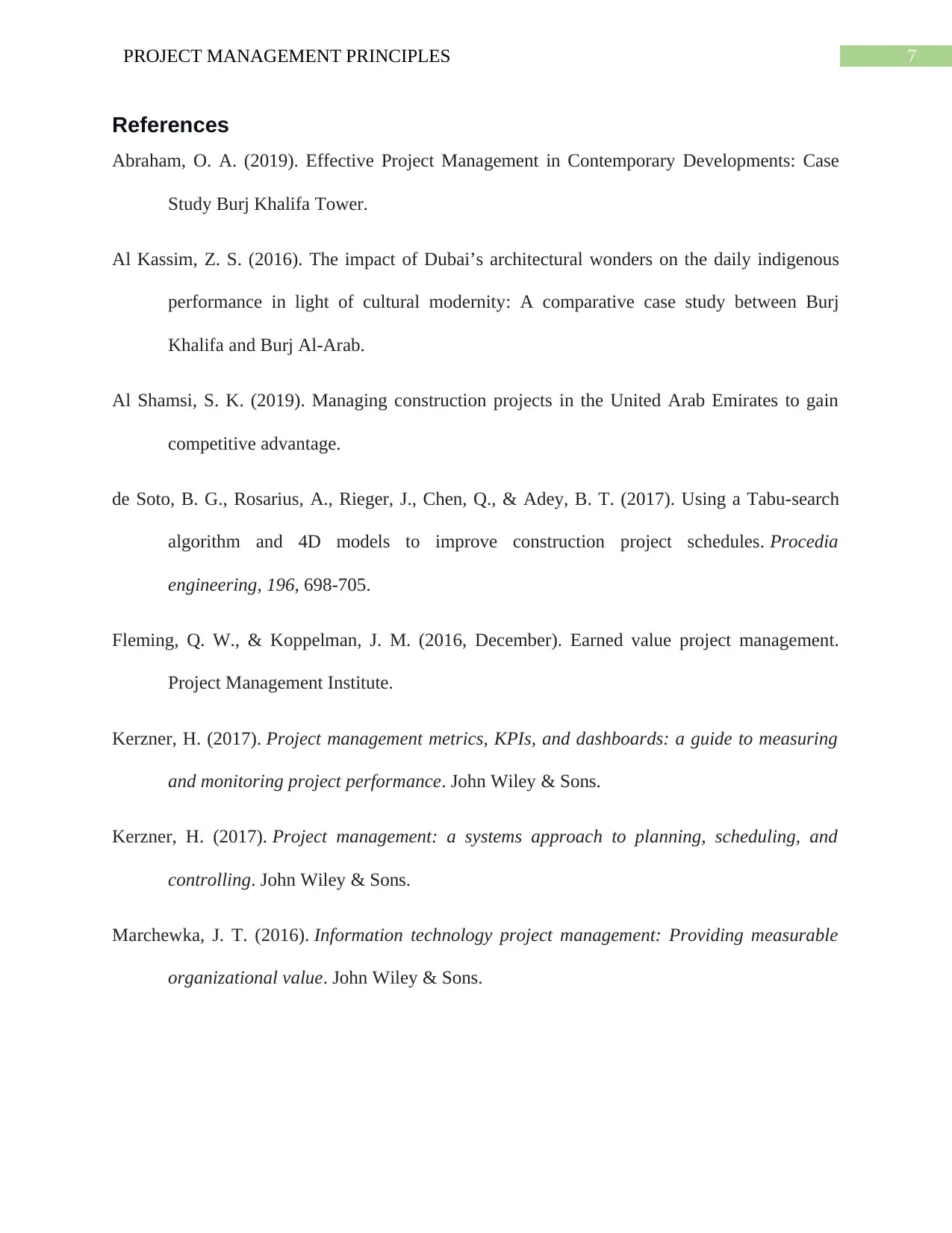
7PROJECT MANAGEMENT PRINCIPLES
References
Abraham, O. A. (2019). Effective Project Management in Contemporary Developments: Case
Study Burj Khalifa Tower.
Al Kassim, Z. S. (2016). The impact of Dubai’s architectural wonders on the daily indigenous
performance in light of cultural modernity: A comparative case study between Burj
Khalifa and Burj Al-Arab.
Al Shamsi, S. K. (2019). Managing construction projects in the United Arab Emirates to gain
competitive advantage.
de Soto, B. G., Rosarius, A., Rieger, J., Chen, Q., & Adey, B. T. (2017). Using a Tabu-search
algorithm and 4D models to improve construction project schedules. Procedia
engineering, 196, 698-705.
Fleming, Q. W., & Koppelman, J. M. (2016, December). Earned value project management.
Project Management Institute.
Kerzner, H. (2017). Project management metrics, KPIs, and dashboards: a guide to measuring
and monitoring project performance. John Wiley & Sons.
Kerzner, H. (2017). Project management: a systems approach to planning, scheduling, and
controlling. John Wiley & Sons.
Marchewka, J. T. (2016). Information technology project management: Providing measurable
organizational value. John Wiley & Sons.
References
Abraham, O. A. (2019). Effective Project Management in Contemporary Developments: Case
Study Burj Khalifa Tower.
Al Kassim, Z. S. (2016). The impact of Dubai’s architectural wonders on the daily indigenous
performance in light of cultural modernity: A comparative case study between Burj
Khalifa and Burj Al-Arab.
Al Shamsi, S. K. (2019). Managing construction projects in the United Arab Emirates to gain
competitive advantage.
de Soto, B. G., Rosarius, A., Rieger, J., Chen, Q., & Adey, B. T. (2017). Using a Tabu-search
algorithm and 4D models to improve construction project schedules. Procedia
engineering, 196, 698-705.
Fleming, Q. W., & Koppelman, J. M. (2016, December). Earned value project management.
Project Management Institute.
Kerzner, H. (2017). Project management metrics, KPIs, and dashboards: a guide to measuring
and monitoring project performance. John Wiley & Sons.
Kerzner, H. (2017). Project management: a systems approach to planning, scheduling, and
controlling. John Wiley & Sons.
Marchewka, J. T. (2016). Information technology project management: Providing measurable
organizational value. John Wiley & Sons.
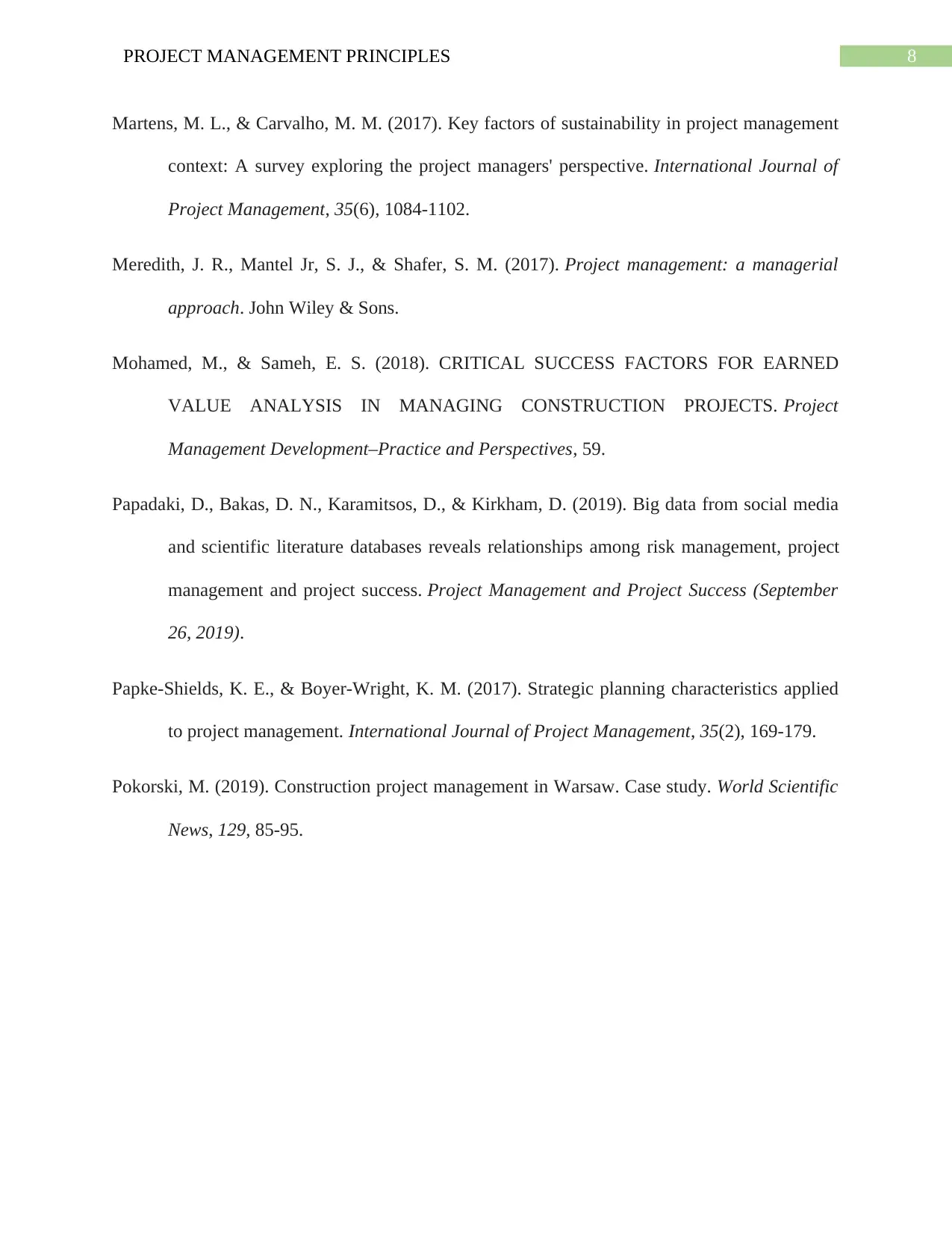
8PROJECT MANAGEMENT PRINCIPLES
Martens, M. L., & Carvalho, M. M. (2017). Key factors of sustainability in project management
context: A survey exploring the project managers' perspective. International Journal of
Project Management, 35(6), 1084-1102.
Meredith, J. R., Mantel Jr, S. J., & Shafer, S. M. (2017). Project management: a managerial
approach. John Wiley & Sons.
Mohamed, M., & Sameh, E. S. (2018). CRITICAL SUCCESS FACTORS FOR EARNED
VALUE ANALYSIS IN MANAGING CONSTRUCTION PROJECTS. Project
Management Development–Practice and Perspectives, 59.
Papadaki, D., Bakas, D. N., Karamitsos, D., & Kirkham, D. (2019). Big data from social media
and scientific literature databases reveals relationships among risk management, project
management and project success. Project Management and Project Success (September
26, 2019).
Papke-Shields, K. E., & Boyer-Wright, K. M. (2017). Strategic planning characteristics applied
to project management. International Journal of Project Management, 35(2), 169-179.
Pokorski, M. (2019). Construction project management in Warsaw. Case study. World Scientific
News, 129, 85-95.
Martens, M. L., & Carvalho, M. M. (2017). Key factors of sustainability in project management
context: A survey exploring the project managers' perspective. International Journal of
Project Management, 35(6), 1084-1102.
Meredith, J. R., Mantel Jr, S. J., & Shafer, S. M. (2017). Project management: a managerial
approach. John Wiley & Sons.
Mohamed, M., & Sameh, E. S. (2018). CRITICAL SUCCESS FACTORS FOR EARNED
VALUE ANALYSIS IN MANAGING CONSTRUCTION PROJECTS. Project
Management Development–Practice and Perspectives, 59.
Papadaki, D., Bakas, D. N., Karamitsos, D., & Kirkham, D. (2019). Big data from social media
and scientific literature databases reveals relationships among risk management, project
management and project success. Project Management and Project Success (September
26, 2019).
Papke-Shields, K. E., & Boyer-Wright, K. M. (2017). Strategic planning characteristics applied
to project management. International Journal of Project Management, 35(2), 169-179.
Pokorski, M. (2019). Construction project management in Warsaw. Case study. World Scientific
News, 129, 85-95.
⊘ This is a preview!⊘
Do you want full access?
Subscribe today to unlock all pages.

Trusted by 1+ million students worldwide
1 out of 9
Related Documents
Your All-in-One AI-Powered Toolkit for Academic Success.
+13062052269
info@desklib.com
Available 24*7 on WhatsApp / Email
![[object Object]](/_next/static/media/star-bottom.7253800d.svg)
Unlock your academic potential
Copyright © 2020–2025 A2Z Services. All Rights Reserved. Developed and managed by ZUCOL.




